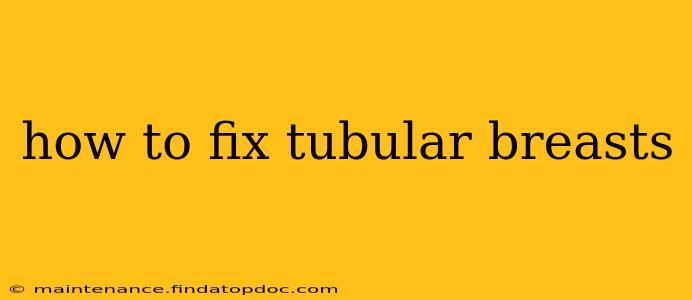How to Address Concerns About Tubular Breasts: A Comprehensive Guide
Tubular breasts, characterized by a narrow, cylindrical shape with minimal projection, are a naturally occurring breast shape affecting many women. While some embrace their natural form, others seek ways to enhance their appearance and address concerns about their breast shape. This guide explores various options for addressing concerns about tubular breasts, emphasizing realistic expectations and responsible decision-making.
What Causes Tubular Breasts?
Tubular breasts are primarily determined by genetics. The amount of fatty tissue and glandular tissue present in the breast influences its shape and size. A lack of sufficient fatty tissue in the upper pole of the breast can lead to this narrow, cylindrical appearance. Hormonal imbalances or significant weight loss can also potentially contribute to a more tubular appearance. Understanding the underlying cause is important when considering potential solutions.
Can Exercise Change the Shape of My Breasts?
Unfortunately, there's no exercise that can directly reshape your breasts. While regular exercise is vital for overall health and can influence body composition, affecting fat distribution, it cannot specifically target breast tissue to alter its shape. Exercises focusing on pectoral muscles may increase muscle mass in the chest area, giving the illusion of fuller breasts, but this won't change the underlying breast tissue structure.
What are the Surgical Options for Tubular Breasts?
Surgical enhancement is the most effective way to significantly change the shape and appearance of tubular breasts. Common surgical procedures include:
-
Breast Augmentation: This involves placing breast implants to increase breast volume and project the breasts more fully. The choice of implant type (saline or silicone) and placement (under the muscle or over the muscle) are crucial decisions to discuss with a plastic surgeon.
-
Breast Lift (Mastopexy): This procedure aims to lift and reshape the breasts, often addressing sagging alongside a lack of projection. It might be recommended alone or in conjunction with breast augmentation for optimal results.
-
Fat Grafting: Fat grafting can be used to add volume to the breasts, particularly in the upper pole, creating a more natural-looking fullness. It's often combined with other procedures.
It's crucial to remember that surgery carries risks and potential complications. Consult a board-certified plastic surgeon to discuss your suitability, potential risks, and expected outcomes for each procedure.
Are There Non-Surgical Options to Improve the Appearance of Tubular Breasts?
While non-surgical options can't fundamentally reshape tubular breasts, they can enhance their appearance:
-
Properly Fitted Bras: Wearing a well-fitting bra can provide support and improve the appearance of breast shape and projection. Consult a bra fitter for assistance in finding the right size and style.
-
Strategic Clothing: Choosing clothes that accentuate the upper body can create a more flattering silhouette.
What is the Recovery Time After Surgery for Tubular Breasts?
The recovery time varies depending on the specific procedure performed. For breast augmentation, expect some discomfort, swelling, and bruising for several weeks. A breast lift often involves a longer recovery period with more significant discomfort and potential scarring. Your surgeon will provide detailed post-operative instructions and guidance for a smooth recovery.
How Much Does it Cost to Fix Tubular Breasts?
The cost of surgical procedures to address tubular breasts varies significantly depending on factors such as the type of surgery, the surgeon's fees, anesthesia costs, and facility fees. It's essential to obtain a detailed breakdown of costs from your surgeon before proceeding.
What Questions Should I Ask My Surgeon Before Surgery?
Before undergoing any surgical procedure, thoroughly discuss the following with your surgeon:
- Your specific goals and expectations.
- The risks and potential complications associated with each procedure.
- The types of implants available and which one is most suitable for you.
- The recovery process and potential downtime.
- The total cost of the procedure and payment options.
- Post-operative care instructions.
Remember to obtain multiple consultations from board-certified plastic surgeons before making a decision. Choosing a qualified and experienced surgeon is paramount to ensuring the best possible outcome and minimizing risks. Thorough research and informed decision-making are essential steps to take before addressing concerns about tubular breasts.
